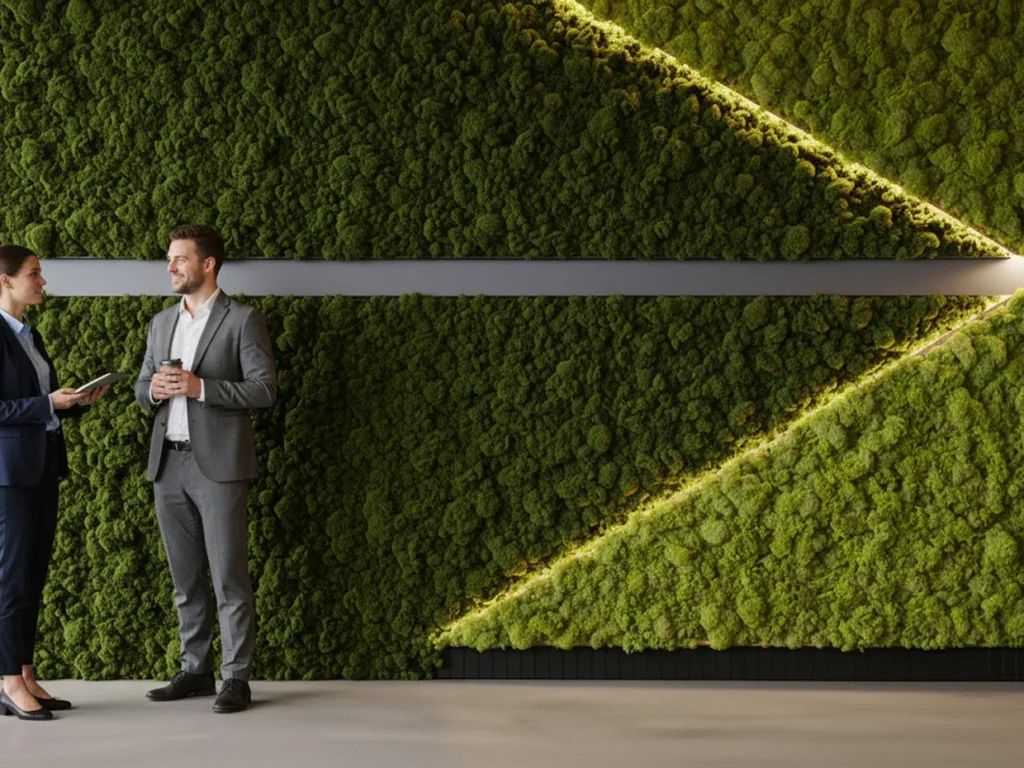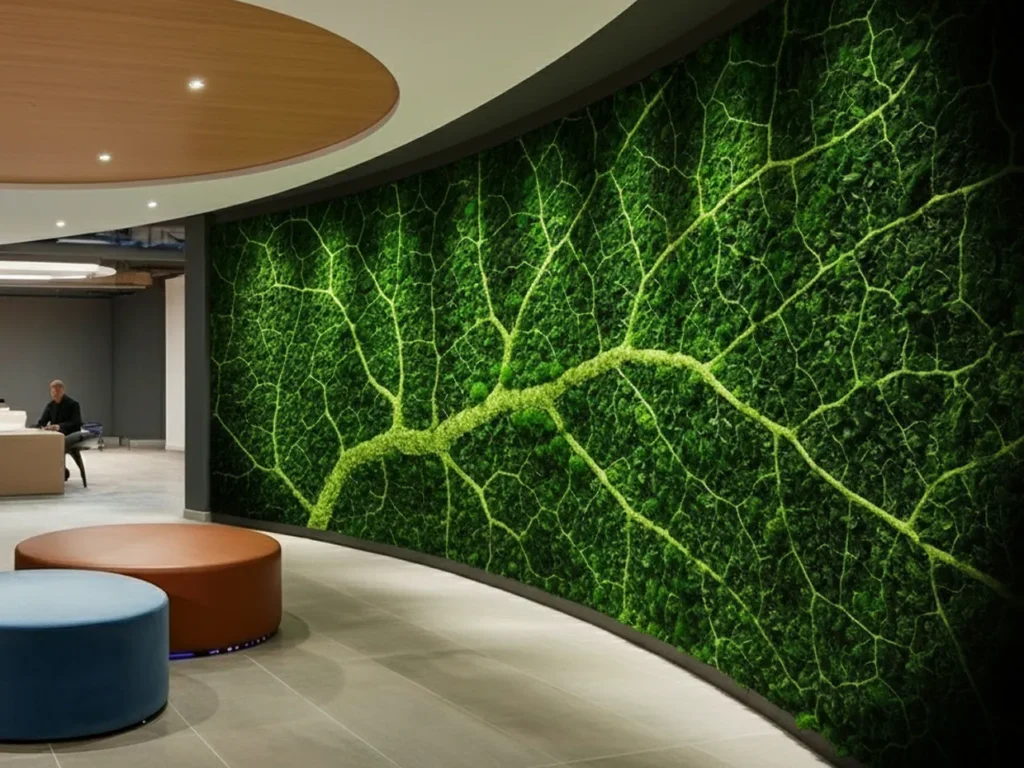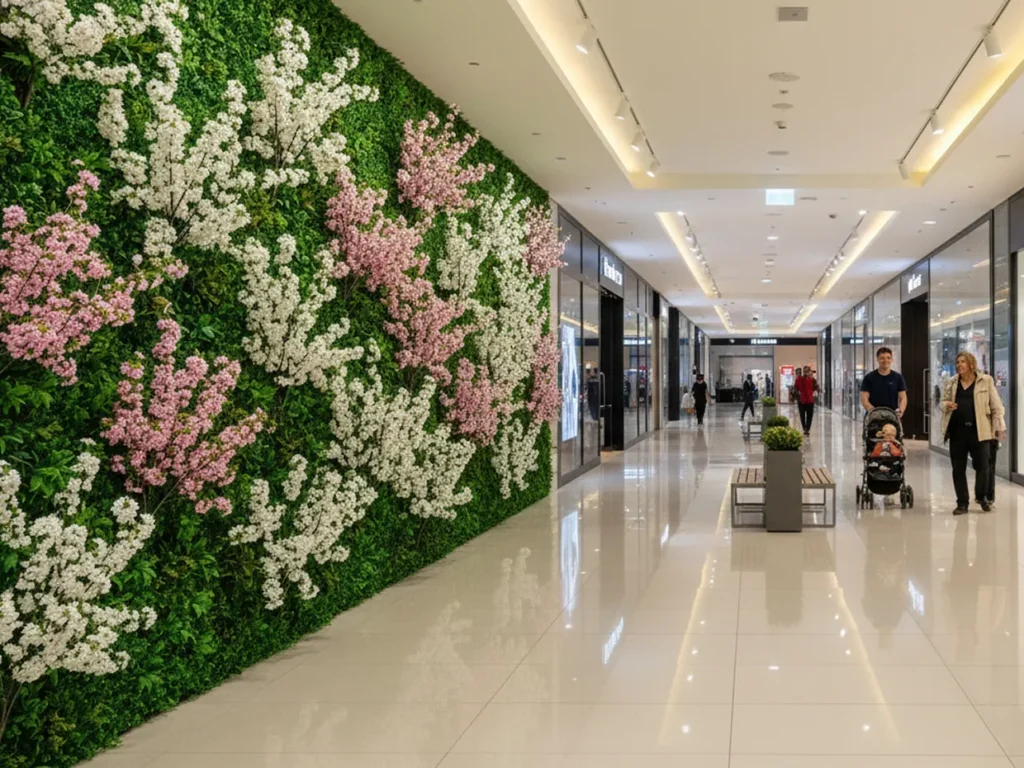

Introduction
“Art with moss” refers to artistic and design compositions that use moss as a primary medium. These can range from framed panels and sculptural pieces to full-scale moss walls. Unlike horticultural plantings, moss art—particularly when created using preserved moss—requires little to no maintenance, making it suitable for interior applications in commercial and institutional settings.
This content piece presents a structural overview of moss types, art formats, commercial applications, design and installation requirements, and specification considerations. Design professionals specifying moss-based solutions will find practical information aligned with architectural planning and interior system integration.
1. Moss Types and Their Properties
1.1 Preserved Moss
Preserved moss is harvested and treated with non-toxic glycerin-based solutions to maintain its form, color, and texture. This process stops biological growth, resulting in a static material suitable for indoor installations that do not require light or watering.
It is commonly integrated into green wall systems for corporate and hospitality interiors where plant care logistics are a constraint.

Aurora, Preserved Moss Wall Art by CSI Creative
1.2 Live Moss
Live moss retains biological activity and continues to grow when provided with proper lighting, humidity, and a suitable substrate. It is typically used in controlled environments such as atriums or wellness spaces with built-in irrigation and lighting systems.
Because of its care requirements, live moss is less common in office or commercial interiors without dedicated plant-care protocols.
1.3 Reindeer Moss
Reindeer moss, technically a lichen, is frequently used in visual compositions for its soft, voluminous texture and wide color range. It is often used in abstract wall patterns or custom signage and is a popular choice for custom preserved moss wall applications.

TerraForm, Preserved & Reindeer Moss Wall Art by CSI Creative
2. Moss Art Formats
2.1 Framed Panels
Framed moss panels consist of moss mounted within wood, aluminum, or composite frames. These modular units are installed similarly to artwork and are frequently used in reception zones, hallways, or meeting rooms.
Designers can explore framed moss applications through custom solution services tailored to project-specific formats.

Collage, Framed Moss Wall Art by CSI Creative
2.2 Full-Surface Moss Walls
This format involves covering entire wall surfaces with preserved moss. These installations are typically panelized for easier mounting and maintenance and are specified in lobbies, lounges, and branding areas.
Design teams can coordinate preserved coverage with moss wall systems built for interior performance and compliance.

Catenaria, Full-Surface Moss Wall Art Design by CSI Creative
2.3 Sculptural and Mixed-Material Works
Some projects incorporate moss in sculptural or mixed-material formats, integrating lighting, branding elements, or fabricated frameworks. These are frequently used in experiential themed environments to create tactile and spatial experiences.

FloraVera, MIxed-Material Green Wall Art by CSI Creative
3. Applications in Commercial and Institutional Interiors
3.1 Offices and Corporate Environments
In corporate interiors, moss art is commonly used to soften rigid architectural lines and create welcoming atmospheres. Installations may appear in lobbies, meeting rooms, and collaboration spaces, contributing to brand expression and acoustic softening.
Preserved moss, due to its stability and ease of care, is frequently chosen for corporate interior projects. It provides visual relief in high-traffic zones and requires no ongoing horticultural maintenance.
3.2 Hospitality and Wellness Spaces
Hotels, resorts, spas, and wellness centers incorporate moss art to establish organic focal points and contribute to a relaxed guest experience. Common applications include reception backdrops, ceiling treatments, or feature walls in lounges.
These spaces often use preserved reindeer moss in brand-aligned colorways. Design teams can review similar applications within hospitality market projects, where visual presence and sensory comfort are essential.
3.3 Education and Healthcare Facilities
In education and healthcare environments, moss-based art supports occupant comfort and helps reduce perceived stress. Installations in classrooms, counseling centers, patient lounges, or administrative offices use preserved moss to introduce greenery without requiring live plant care protocols.
Examples of moss applications in these sectors can be explored through healthcare project references, where low-maintenance biophilic features are often specified.
3.4 Civic, Public, and Cultural Spaces
Civic buildings, libraries, galleries, and transportation terminals use moss installations to convey messages of sustainability, local identity, or artistic expression. Full-wall compositions or sculptural elements act as placemaking devices while requiring minimal infrastructure.
Project teams can explore moss-based works in public space applications where large-scale integration and durability are key considerations.
4. Installation and Structural Considerations
4.1 Mounting and Substrate Options
Moss art installations are typically mounted to substrates such as felt, MDF, plywood, aluminum composite panels, or PVC boards. These substrates must be compatible with adhesives and must support the overall load of the moss and frame (if applicable).
For modularity and ease of maintenance, large-scale moss walls are often built as panelized systems. Installers should plan for tolerance gaps and access points for inspection or replacement. Panels may be affixed using cleats, brackets, or direct anchoring, depending on wall condition and substrate.
Specifiers should consult framing and support strategies aligned with custom solutions for large-scale moss systems.

4.2 Fire Code Compliance
Preserved moss and mounting components must meet interior fire code requirements. In the United States, this typically includes ASTM E84 Class A standards for flame spread and smoke development. Designers should confirm fire ratings for all composite materials and adhesives used in the installation.
Where moss is integrated with lighting or signage, additional clearances or protective barriers may be required to avoid heat concentration near organic materials.
4.3 Environmental Conditions
Preserved moss is designed for indoor use and requires stable humidity levels between 40–60%. Excessive dryness may cause brittleness, while high humidity can lead to color shifts or microbial growth.
Live moss requires significantly more attention, including access to natural or artificial light and consistent misting or irrigation. The environment must be evaluated for UV exposure, airflow, and temperature control.
Specifiers considering moss for acoustical integration can explore acoustic greenery which combines visual and functional properties.
5. Maintenance Planning
5.1 Preserved Moss
Preserved moss is static and non-living, which eliminates the need for watering, pruning, or fertilization. Its primary maintenance requirement is occasional dusting, typically once or twice per year. Dust accumulation can be addressed with low-powered vacuum systems or air blowers.
If exposed to direct sunlight or high humidity, preserved moss may degrade over time. Design teams should specify installations away from HVAC diffusers, exterior glazing, or heat sources. Lifecycle expectations range from 8 to 10 years under stable indoor conditions.
5.2 Live Moss
Live moss installations require horticultural oversight, including routine misting, substrate monitoring, and potential replanting. The need for continued upkeep may limit its feasibility in office or institutional spaces without dedicated facility staff.
Live moss compositions in wellness-focused environments—such as spas or therapy centers—should be specified only when reliable irrigation and light conditions can be confirmed.
5.3 Maintenance Access
Regardless of moss type, all installations should be designed with access provisions. These include removable panel sections, structural clearance behind panels, and lighting maintenance routes. Access planning ensures that moss integrity can be preserved over time without compromising wall finishes or built-in systems.
6. Specification Guidelines
6.1 Project Criteria and Product Selection
When specifying moss art, the following criteria must be clearly defined in the design documentation:
- Type of moss: preserved, live, or lichen-based (e.g., reindeer moss)
- Mounting system: direct adhesive, cleated panel, framed unit
- Substrate material: plywood, MDF, aluminum composite, PVC, felt.
- Fire performance: fire-rated backing and adhesive meeting ASTM or local standards
- Environmental requirements: humidity, UV exposure, HVAC proximity
- Maintenance approach: dusting frequency, access needs, replacement protocol
- Installation constraints: panelization, fastener location, edge finishing
Project teams may request tailored design and delivery approaches through custom moss solutions suited to project-specific conditions.
6.2 Modular Design and Lifecycle Planning
Modular design supports efficient installation, inspection, and part replacement. Installations should avoid continuous, seamless surfaces unless conditions allow for full-wall reinstallation in case of failure.
In branding or identity-driven spaces, preserved moss logos or feature panels should be planned as discrete modules that can be removed or updated with minimal disruption.
7. Acoustic and Visual Considerations
7.1 Acoustic Benefits
Preserved moss has limited but useful acoustic properties. When mounted over sound-absorptive backings, such as felt or porous composites, it can assist with mid- to high-frequency sound dampening. These installations are often applied in open-plan offices, corridors, or conference rooms.
Integrated moss systems designed for acoustic support may be reviewed in Soundcore® systems, which combine material layers for both absorption and visual appeal.
7.2 Color, Texture, and Light Interaction
Color uniformity in preserved moss is highly stable under indirect light conditions. For applications in reception zones or lounges with focused lighting, light temperature and direction should be reviewed during mockup phases. Over time, direct sunlight can lead to color shift or drying.
Texture variation can be introduced by mixing moss types (e.g., flat sheet moss with reindeer moss) to add visual depth. Designers often alternate material zones to mimic landscape forms or graphic patterns.
8. Sustainability and Sourcing Considerations
8.1 Environmental Impact of Harvesting
Moss used in artistic and architectural applications is often harvested from natural forest environments. Ethical sourcing practices involve selective harvesting, compliance with regional environmental regulations, and ecosystem recovery strategies. However, commercially available moss is sometimes collected without long-term ecological safeguards.
Design professionals seeking to specify preserved moss in large volumes should request sourcing transparency from suppliers. This includes details on harvest location, regeneration practices, and transport distances.
Moss products integrated into green wall applications may be backed by declarations related to sourcing ethics or sustainability certifications. These documents can support alignment with LEED, WELL, or similar frameworks.
8.2 Preservation Process and Material Use
Preserving moss involves the use of glycerin, colorants, and stabilizing agents. The environmental impact of these compounds is generally low when handled in industrial processing environments, but documentation should confirm their safety for interior applications, particularly in healthcare or educational settings.
Specifiers should assess material safety data sheets (MSDS) and confirm that adhesives and backings are free of VOCs, formaldehyde, and other restricted compounds.
9. Moss Art Compared to Other Biophilic Elements
9.1 Moss vs. Living Plant Walls
Preserved moss walls differ significantly from living plant walls in both performance and maintenance. While living walls offer air purification and oxygen release, they require irrigation systems, growth substrates, and specialized maintenance contracts.
In contrast, moss-based installations provide visual greenery without water infrastructure, making them suitable for retrofits or enclosed interiors without natural light access. This distinction often influences product selection in commercial retrofits or tenant improvement (TI) scenarios.

Mandara, Artificial Greenery Wall Art by CSI Creative
9.2 Moss vs. Natural Wood and Felt Panels
Compared to wood paneling or felt baffles, moss provides a more organic texture and three-dimensional visual depth. Though it may not match the acoustic absorption of thick felt composites, moss panels can supplement acoustics when layered over perforated or porous materials.
Professionals working with wood textures or acoustic greenery may consider moss a complementary layer in hybrid ceiling or wall compositions.
Conclusion
Moss art introduces a visually distinct and maintenance-efficient natural element into interior spaces. Its flexibility in format—ranging from framed panels to full wall coverage and sculptural integrations—allows design teams to meet branding, acoustic, and biophilic objectives without the constraints of live plant systems.
Preserved moss offers long-term value with minimal upkeep, while live moss provides dynamic visual and tactile qualities when conditions permit. Key considerations for specification include fire safety compliance, substrate compatibility, environmental stability, and vendor sourcing practices.
By integrating moss art thoughtfully within spatial programs, project teams can deliver installations that balance performance, aesthetic intent, and operational practicality across a range of commercial and institutional contexts.







